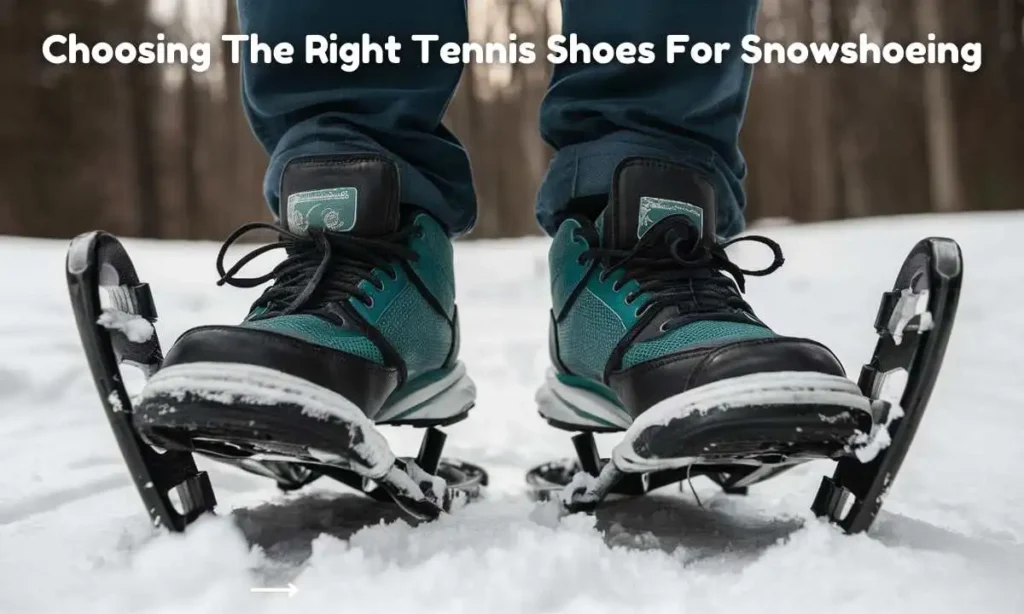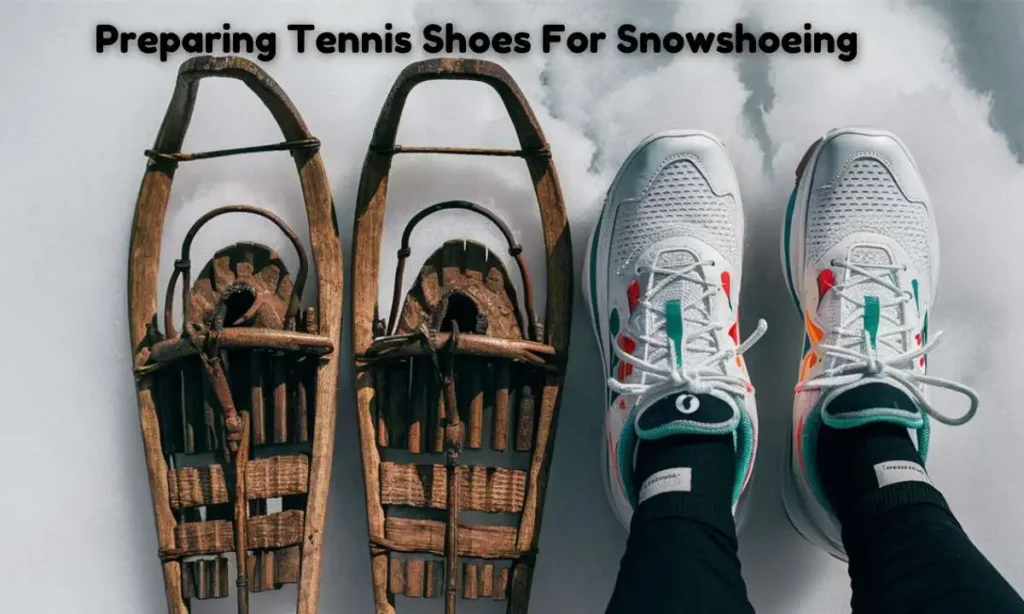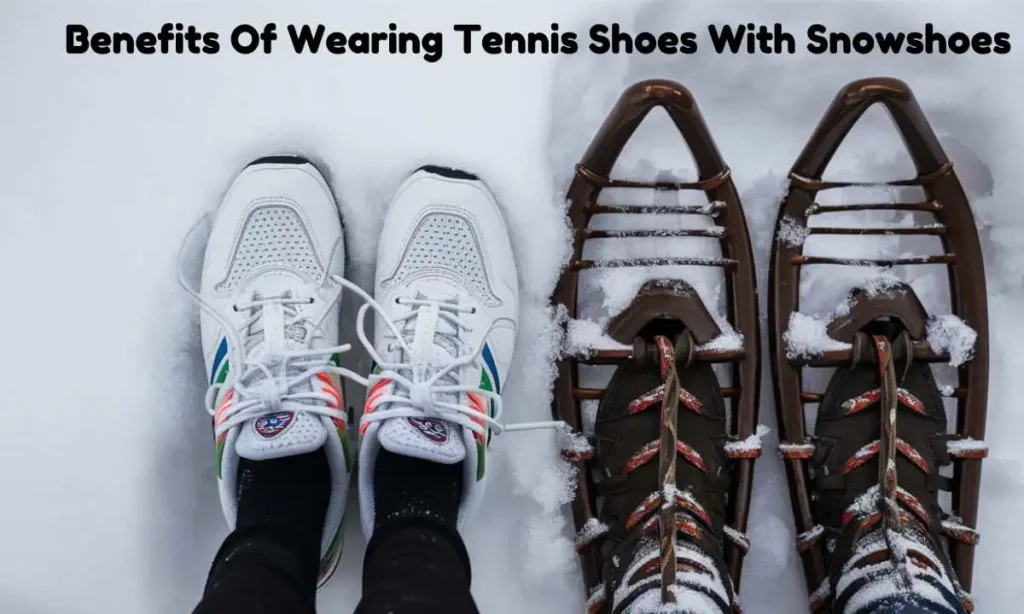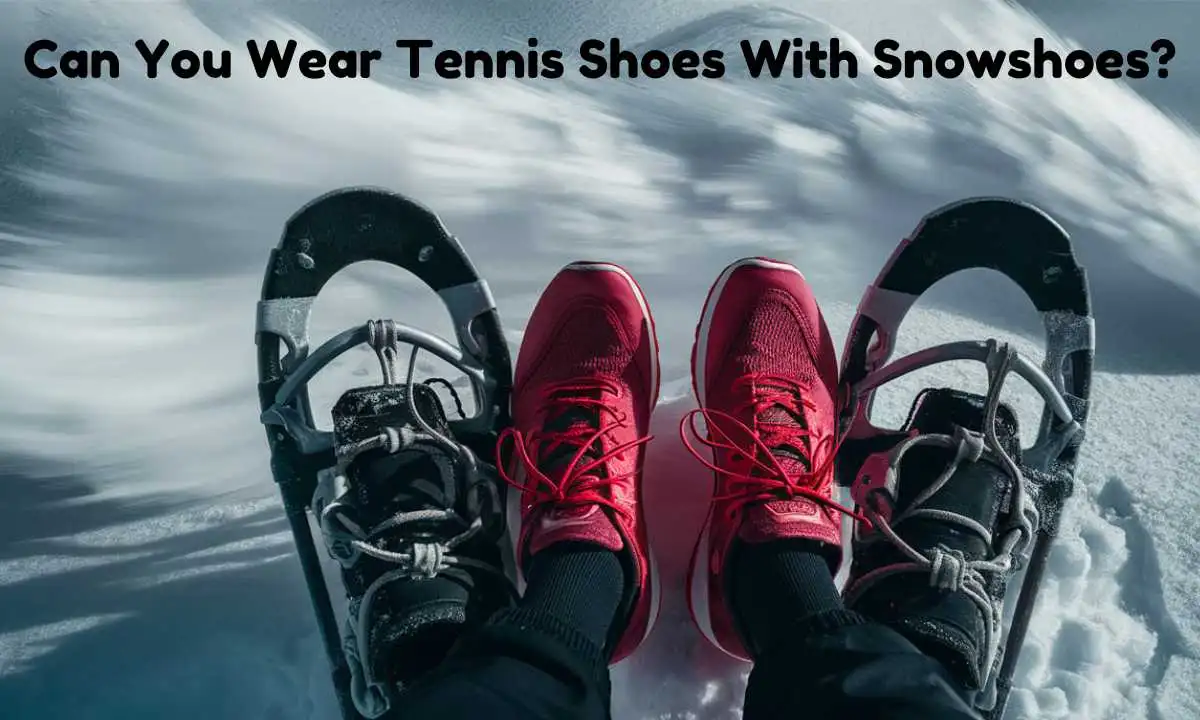No, you should not wear tennis shoes with snowshoes. Tennis shoes lack the insulation and grip needed for snowshoeing.
Snowshoeing requires footwear that can handle cold, wet, and slippery conditions. Tennis shoes are not designed for such environments. Snowshoes work best with insulated, waterproof boots that provide ankle support and warmth. Proper footwear prevents frostbite and ensures a secure fit with the snowshoes.
Investing in quality snow boots enhances your snowshoeing experience. Choose boots with good traction, insulation, and waterproof features. This will keep your feet dry, warm, and comfortable. Always prioritize safety and comfort when selecting footwear for snowshoeing. Enjoy the winter trails with the right gear.
Can You Wear Tennis Shoes With Snowshoes
Snowshoeing is a fantastic winter activity that allows you to explore snowy landscapes. But what if you don’t have specialized winter boots? You might wonder, “Can you wear tennis shoes with snowshoes?” Whether you’re a woman, man, or kid, the idea of using tennis shoes with snowshoes might cross your mind. Let’s dive into the details.
Considerations For Wearing Tennis Shoes With Snowshoes
Wearing tennis shoes with snowshoes is possible, but several factors should be considered to ensure comfort and safety.
Weather Conditions: Tennis shoes are not designed for cold, wet environments. If the weather is extremely cold or snowy, tennis shoes won’t provide adequate insulation.
Foot Protection: Tennis shoes lack the ankle support and waterproof features of snow boots. This can lead to cold, wet feet, which is not only uncomfortable but also dangerous.
Snowshoe Compatibility: Not all tennis shoes fit well into snowshoe bindings. Ensure your shoes fit securely to avoid slipping or discomfort.
Here’s a quick comparison table for better understanding:
| Feature | Tennis Shoes | Snow Boots |
|---|---|---|
| Insulation | Low | High |
| Waterproof | No | Yes |
| Ankle Support | Low | High |
Pros And Cons Of Wearing Tennis Shoes With Snowshoes
Understanding the benefits and drawbacks can help you decide if wearing tennis shoes with snowshoes is right for you.
Pros:
- Convenience: You likely already own tennis shoes, making it a convenient option.
- Flexibility: Tennis shoes are generally more flexible and lighter than snow boots.
- Cost-Effective: You save money by not purchasing specialized snow boots.
Cons:
- Insulation Issues: Tennis shoes lack the insulation needed for cold, snowy conditions.
- Waterproofing: Tennis shoes are not waterproof, leading to wet and cold feet.
- Ankle Support: Tennis shoes do not provide the ankle support necessary for uneven terrain.
Tips For Wearing Tennis Shoes With Snowshoes
If you decide to wear tennis shoes with snowshoes, follow these tips to improve your experience.
Layer Up: Wear thick, moisture-wicking socks to keep your feet warm and dry.
Use Gaiters: Gaiters can help keep snow out of your shoes, adding an extra layer of protection.
Check Fit: Ensure your tennis shoes fit snugly in the snowshoe bindings to prevent slipping.
Choose the Right Shoes: Opt for tennis shoes that are slightly water-resistant and have good traction.
These tips apply whether you’re asking “can you wear tennis shoes with snowshoes for women”, “Can you wear tennis shoes with snowshoes for men”, or even “Can you wear tennis shoes with snowshoes kids”. By following these guidelines, you can make your snowshoeing adventure more enjoyable.
Whether you’re curious about “Can you wear tennis shoes with snowshoes for girls” or “Can you wear tennis shoes with snowshoes wide”, the same principles apply. Ensuring a good fit and proper protection is key to a successful outing.
Choosing The Right Tennis Shoes For Snowshoeing

Snowshoeing can be a fun winter activity. But can you wear tennis shoes with snowshoes? The answer is yes if you choose the right pair. Picking the right tennis shoes for snowshoeing ensures comfort and safety. Let’s explore the key features you need to look for in tennis shoes to make your snowshoeing experience enjoyable.
Tennis Shoes With Good Traction
Good traction is crucial for snowshoeing. Slippery surfaces can be dangerous. You need tennis shoes with excellent grip. Look for shoes with deep lugs on the soles. Deep lugs dig into snow and ice. This helps you stay steady.
Consider shoes with a rubber outsole. Rubber provides a firm grip. Shoes with a multi-directional tread pattern are also ideal. This pattern offers stability in different directions.
Here’s a table to help you understand better:
| Feature | Benefit |
|---|---|
| Deep Lugs | Better grip on snow and ice |
| Rubber Outsole | Firm grip on slippery surfaces |
| Multi-directional Tread | Stability in all directions |
Always check the sole of the shoe. It should be sturdy yet flexible. This flexibility helps in comfortable walking. A shoe with good traction will keep you safe during your snowshoeing adventure.
Waterproof Tennis Shoes
Snow is wet. Wet shoes make your feet cold and uncomfortable. Waterproof tennis shoes keep your feet dry. Look for shoes made with water-resistant materials. Gore-Tex is a popular choice. It keeps water out but lets your feet breathe.
Check the shoe’s seams. Sealed seams prevent water from getting inside. Consider shoes with a waterproof membrane. This adds an extra layer of protection.
Here’s what to look for in waterproof shoes:
- Water-resistant materials like Gore-Tex
- Sealed seams
- Waterproof membrane
Waterproof shoes are essential for snowshoeing. They keep your feet dry and warm. Dry feet are happy feet. This feature is non-negotiable for a pleasant snowshoeing experience.
Insulated Tennis Shoes
Cold feet can ruin your snowshoeing fun. Insulated tennis shoes keep your feet warm. Look for shoes with thermal insulation. Thinsulate is a common insulating material. It traps heat inside the shoe.
Insulated shoes often have a fleece lining. Fleece adds an extra layer of warmth and comfort. Check for shoes with removable liners. Removable liners can be dried separately. This keeps the shoes fresh and warm.
Consider these features for insulation:
- Thermal insulation like Thinsulate
- Fleece lining
- Removable liners
Insulated shoes are a must for snowshoeing. They ensure your feet stay warm. Warm feet make your snowshoeing adventure more enjoyable. Insulation is key to comfort in cold weather.
Preparing Tennis Shoes For Snowshoeing

Many wonder if they can wear tennis shoes with snowshoes. The good news is that you can, but you need to prepare them correctly. Preparing tennis shoes for snowshoeing ensures comfort, safety, and warmth in snowy conditions. Here’s how to get your tennis shoes ready for snowshoeing adventures.
Adding Traction To Tennis Shoes
Snowy terrain is slippery, making traction essential. Adding traction to tennis shoes helps you maintain stability and prevent falls.
Consider using these methods to improve traction:
- Traction Cleats: These are attachable spikes that provide excellent grip. You can easily strap them on your shoes.
- DIY Solutions: You can use screws or nails to create a makeshift traction system. Make sure to place them evenly.
Here’s a quick comparison of options:
| Method | Pros | Cons |
|---|---|---|
| Traction Cleats | Easy to attach, removable, effective | Can be expensive |
| DIY Solutions | Cost-effective, customizable | May damage shoes, less durable |
Adding traction significantly improves your snowshoeing experience, ensuring safety and comfort.
Waterproofing Tennis Shoes
Keeping your feet dry is crucial in snowy conditions. Waterproofing your tennis shoes helps prevent soggy, uncomfortable feet.
To waterproof your shoes, consider the following steps:
- Use a Waterproof Spray: Apply a waterproof spray designed for fabric shoes. Make sure to cover all areas, including seams.
- Wax Coating: Rub a waterproof wax on the surface of the shoes. This method works well for leather or synthetic materials.
- Waterproof Liners: Insert waterproof liners inside your shoes. These add an extra layer of protection.
Here’s a quick guide on waterproofing methods:
| Method | Application | Effectiveness |
|---|---|---|
| Waterproof Spray | Spray on fabric | High |
| Wax Coating | Rub on surface | Moderate |
| Waterproof Liners | Insert inside shoe | High |
Waterproofing ensures your feet stay dry and warm, making your snowshoeing trip more enjoyable.
Using Gaiters With Tennis Shoes
Gaiters are a great addition to your snowshoeing gear. They keep snow and moisture out of your shoes, providing extra protection.
Here’s how to use gaiters with tennis shoes:
- Select the Right Gaiters: Choose gaiters that fit well over your tennis shoes. They should cover the top of your shoes and extend up your legs.
- Attach Properly: Secure the gaiters around your shoes and legs. Most gaiters have straps and hooks to ensure a snug fit.
- Check for Gaps: Make sure there are no gaps where snow can enter. Adjust the gaiters as needed for a tight seal.
Benefits of using gaiters:
| Benefit | Description |
|---|---|
| Keep Snow Out | Prevents snow from entering shoes |
| Added Warmth | Provides additional insulation |
| Protects Shoes | Shields shoes from moisture and debris |
Using gaiters with tennis shoes ensures your feet stay dry, warm, and protected from snow, enhancing your snowshoeing experience.
Benefits Of Wearing Tennis Shoes With Snowshoes

Can you wear tennis shoes with snowshoes? This question often arises for those new to snowshoeing. Surprisingly, tennis shoes can be a viable option. Let’s explore the benefits of wearing tennis shoes with snowshoes.
Comfort And Flexibility
Tennis shoes provide unmatched comfort and flexibility when paired with snowshoes. Their design allows for a full range of motion, making it easier to walk naturally. Here are some key points:
- Soft cushioning for all-day comfort
- Flexible soles that adapt to your movements
- Less restrictive compared to heavy boots
Wearing tennis shoes with snowshoes can reduce fatigue. The lightweight design of tennis shoes minimizes the strain on your feet and ankles. Additionally, tennis shoes often have breathable materials, keeping your feet dry and comfortable during long hikes.
Lightweight And Breathable
The lightweight nature of tennis shoes makes them ideal for snowshoeing. Heavier boots can weigh you down, but tennis shoes offer a lighter alternative. Benefits include:
- Reduced fatigue due to lighter weight
- Increased speed and agility
- Better control over your movements
Furthermore, tennis shoes are generally made of breathable materials. This breathability helps to prevent overheating and sweating, which is crucial in cold weather. Here’s a quick comparison:
| Feature | Tennis Shoes | Heavy Boots |
|---|---|---|
| Weight | Light | Heavy |
| Breathability | High | Low |
| Flexibility | High | Low |
Versatility And Convenience
Tennis shoes offer versatility and convenience that heavy boots simply cannot match. They can be used for various activities beyond snowshoeing, making them a practical choice. Key advantages include:
- Multi-purpose use – suitable for different sports and activities
- Easy to pack and carry
- Quick to put on and take off
Tennis shoes are also more cost-effective. Investing in a good pair of tennis shoes can serve multiple purposes, reducing the need for specialized footwear. This versatility extends to transitional weather conditions, where you might encounter both snow and dry paths.
For those seeking convenience and practicality, tennis shoes with snowshoes offer a perfect solution. They provide the flexibility needed for various terrains and activities.
Drawbacks Of Wearing Tennis Shoes With Snowshoes
Tennis shoes may seem convenient for snowshoeing, but they come with several drawbacks. These shoes lack the features necessary for cold, wet, and rugged conditions. Let’s explore the main issues with wearing tennis shoes with snowshoes.
Lack Of Insulation
Tennis shoes generally lack proper insulation. This makes them unsuitable for snowy conditions. Insulation is critical for keeping your feet warm in cold temperatures. Tennis shoes don’t provide this necessary warmth.
Snowshoes are designed to be used in winter environments. Without insulated footwear, your feet can quickly become cold and uncomfortable. Here are some points to consider:
- Material: Tennis shoes are usually made of lightweight materials. These materials do not retain heat.
- Design: Tennis shoes are designed for breathability, not warmth. They allow cold air to enter easily.
- Comfort: Lack of insulation can lead to frostbite or cold-related injuries. Insulated boots are essential for safety.
Limited Protection From Cold And Moisture
Tennis shoes offer limited protection from cold and moisture. These shoes are not waterproof. Snow can easily seep into the shoes, making your feet wet and cold.
Here are some key points to consider:
- Waterproofing: Tennis shoes are not designed to be waterproof. Snow and moisture can penetrate the fabric.
- Cold Resistance: Tennis shoes do not protect against freezing temperatures. They lack the necessary features to keep your feet warm.
- Health Risks: Wet and cold feet can lead to health issues. Hypothermia and frostbite are serious risks.
A table comparing features can help highlight the differences:
| Feature | Tennis Shoes | Insulated Boots |
|---|---|---|
| Waterproof | No | Yes |
| Insulation | No | Yes |
| Cold Resistance | Low | High |
Potential Damage To Tennis Shoes
Wearing tennis shoes with snowshoes can cause potential damage. These shoes are not built for rugged terrain. Snowshoes add extra strain, leading to wear and tear.
Consider these points:
- Durability: Tennis shoes are not durable enough for snowshoeing. Rough terrain can cause them to wear out quickly.
- Traction: Tennis shoes lack the traction needed for snowy conditions. This can lead to slips and falls.
- Structural Integrity: The added stress from snowshoes can damage the shoe structure. This can make them unusable for their intended purpose.
Investing in proper snowshoeing boots is essential. These boots are designed to handle the conditions you’ll face. Protecting your feet and your footwear is vital for a safe and enjoyable experience.
Tips For Safe And Enjoyable Snowshoeing With Tennis Shoes
Snowshoeing is a fantastic winter activity, but many wonder, “Can you wear tennis shoes with snowshoes?” The answer is yes, with some precautions. Here are tips for safe and enjoyable snowshoeing with tennis shoes.
Choose Appropriate Terrain
Not all terrains are suitable for tennis shoes. Stick to flat or gently rolling terrain to avoid slipping or getting stuck.
- Avoid steep slopes and rugged trails.
- Look for well-packed snow trails.
- Prefer groomed paths in popular snowshoeing areas.
Here’s a table to help you choose the best terrain:
| Terrain Type | Suitability |
|---|---|
| Flat Trails | Excellent |
| Rolling Hills | Good |
| Steep Slopes | Poor |
| Rugged Trails | Unsuitable |
Choosing the right terrain ensures a safer and more enjoyable snowshoeing experience with tennis shoes.
Monitor Weather Conditions
Weather plays a crucial role in your snowshoeing adventure. Always check the weather forecast before heading out.
- Look for clear skies or light snow conditions.
- Avoid going out during storms or extreme cold.
- Pay attention to temperature changes throughout the day.
Understanding the weather helps you prepare better. Here’s a quick guide:
| Weather Condition | Recommendation |
|---|---|
| Clear Skies | Ideal |
| Light Snow | Acceptable |
| Heavy Snow | Risky |
| Storm | Unsafe |
Monitoring the weather ensures you avoid dangerous situations and stay safe.
Dress In Layers
Wearing tennis shoes means your feet might get cold. Dressing in layers helps keep your body warm.
- Start with a moisture-wicking base layer.
- Add an insulating middle layer.
- Finish with a waterproof outer layer.
Here’s a recommended layering system:
| Layer | Purpose |
|---|---|
| Base Layer | Moisture-wicking |
| Middle Layer | Insulation |
| Outer Layer | Waterproof |
Keeping your body warm is essential for an enjoyable snowshoeing experience. Use layers to regulate your body temperature effectively.
Alternatives To Wearing Tennis Shoes With Snowshoes
Are you curious about whether you can wear tennis shoes with snowshoes? While tennis shoes are comfortable, they might not be the best choice for snowshoeing. There are several alternatives to wearing tennis shoes with snowshoes that offer better protection and comfort. Let’s explore some of the best options below.
Winter Hiking Boots
Winter hiking boots are a fantastic alternative to tennis shoes for snowshoeing. These boots are designed to keep your feet warm and dry in snowy conditions. They provide better support and traction compared to tennis shoes.
Here are some key features of winter hiking boots:
- Waterproof materials to keep your feet dry
- Insulated lining to retain heat
- Sturdy soles for better grip on snow and ice
- High ankle support to prevent injuries
Winter hiking boots come in various styles and price ranges. You can find a pair that fits your budget and preferences. These boots are also versatile, making them suitable for other winter activities like hiking and trekking.
Choosing winter hiking boots ensures you have the necessary protection and comfort for your snowshoeing adventure.
Snow Boots
Snow boots are another great alternative to tennis shoes for snowshoeing. These boots are specifically designed for snowy and icy conditions, offering excellent insulation and waterproofing.
Key features of snow boots include:
- Thick insulation to keep your feet warm
- Waterproof outer layer to prevent moisture
- Non-slip soles for better traction on snow and ice
- High shafts to keep snow out
Snow boots are generally bulkier than winter hiking boots, but they offer superior warmth and protection. They are ideal for deep snow and extremely cold temperatures.
Snow boots come in various designs, including stylish options for everyday wear. If you live in an area with heavy snowfall, investing in a good pair of snow boots is a wise decision.
Specialized Snowshoeing Boots
Specialized snowshoeing boots are the best choice for serious snowshoers. These boots are specifically designed for snowshoeing, offering maximum comfort and performance.
Features of specialized snowshoeing boots include:
- Lightweight construction to reduce fatigue
- Enhanced insulation to keep feet warm
- Waterproof materials to keep feet dry
- Advanced grip technology for better traction
Specialized snowshoeing boots often come with features like integrated gaiters to prevent snow from entering the boots. They are designed to work seamlessly with snowshoes, ensuring a secure and comfortable fit.
Although these boots can be more expensive, they provide the best experience for snowshoeing enthusiasts. If you plan to snowshoe frequently, investing in a pair of specialized snowshoeing boots is highly recommended.
Frequently Asked Questions
Can I Wear Sneakers In Snowshoes?
Yes, but it’s not ideal. Sneakers lack insulation and waterproofing. Wear insulated, waterproof boots for better protection and comfort in snowshoes.
What Kind Of Shoes To Wear With Snowshoes?
Wear waterproof, insulated boots with good ankle support. Ensure they fit comfortably with thick, moisture-wicking socks.
Can We Wear Normal Sports Shoes In Snow?
Wearing normal sports shoes in snow is not advisable. They lack insulation and traction, making slips likely. Opt for snow-specific footwear.
Conclusion
Combining tennis shoes with snowshoes can be tricky. It’s best to wear proper winter boots for safety and comfort. Tennis shoes lack insulation and support in snowy conditions. Always prioritize appropriate gear to enjoy your snowy adventures. Stay warm, stay safe, and make the most of your outdoor experiences.



Leave a Reply